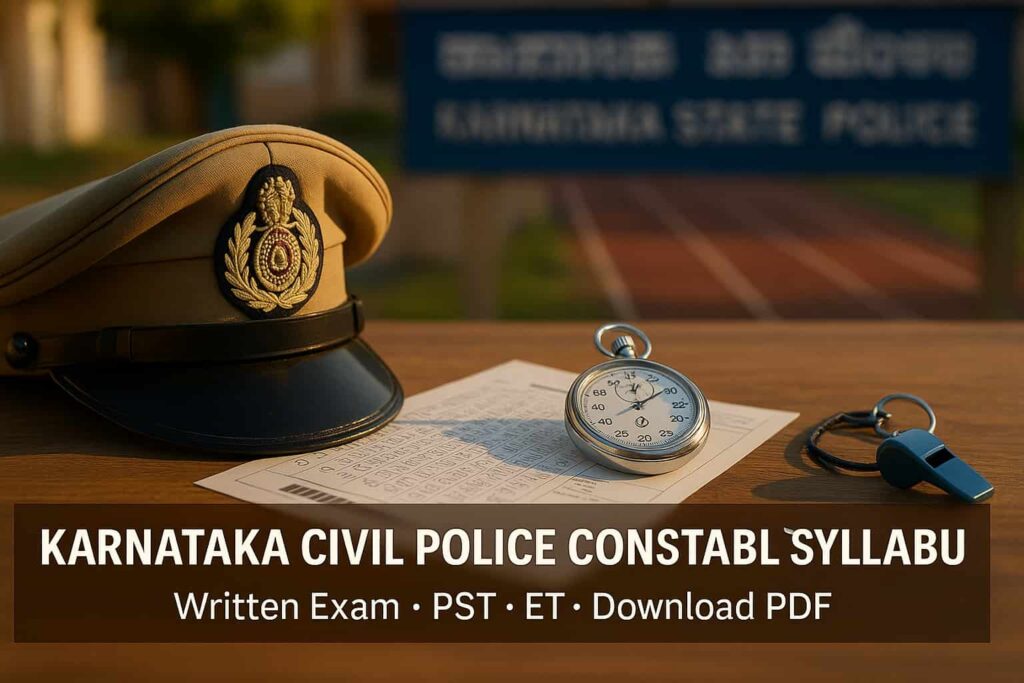KARTET Syllabus — Paper 1 & Paper 2 (in English)
Preparing for the Karnataka Teacher Eligibility Test (KARTET)? This guide presents the complete KARTET syllabus in English for Paper 1 (Classes 1–5) and Paper 2 (Classes 6–8) with the latest exam pattern, topic-wise coverage (CDP, Language I, Language II, Mathematics, EVS / Mathematics & Science / Social Studies), marking scheme, qualifying marks, and the official Karnataka TET syllabus PDF link. Use this page as an evergreen reference to plan your preparation, revise faster, and align your study notes with the Karnataka TET syllabus and previous-year trends.
Quick Overview
📘 Exam
Karnataka Teacher Eligibility Test (KARTET) — state-level eligibility for Primary and Upper Primary teachers.
🏛️ Exam Authority
Conducted by the competent Karnataka education authority; syllabus broadly aligns with NCTE guidelines.
📝 Papers
Paper 1 (Classes 1–5) and Paper 2 (Classes 6–8). You may take one or both based on your target level.
⏱️ Duration & Pattern
Each paper: 2 hours 30 minutes; 150 objective (MCQ) questions = 150 marks. Typically no negative marking.
🗣️ Languages / Medium
Question papers are available in multiple languages. Language I is usually the teaching medium; Language II is commonly English/other.
🎓 Eligibility (brief)
Paper 1: D.El.Ed (ongoing/completed). Paper 2: B.Ed-related eligibility. Always verify the latest notification.
✅ Qualifying Marks
Generally 60% to qualify (category relaxations may apply). Final cut-offs/criteria are as per official rules.
📄 TET Certificate Validity
Validity is as notified by the department. Follow current guidelines published on the official portal.
🔤 Language Rule
Language II must be different from Language I. Example: if Language I is Kannada, choose English/other for Language II.
🧭 Who should take which paper?
Paper 1 → PRT (Classes 1–5). Paper 2 → Upper Primary (Classes 6–8). Need eligibility for both levels? Take both papers.
🖥️ Exam Mode
Typically OMR-based offline. Exact mode and centers are confirmed in each notification/admit card.
🔁 Attempts
No fixed limit in general; you can re-attempt to qualify or improve your score, subject to official norms.
Paper 1 — Exam Pattern (Classes 1–5)
Subject-wise Weightage
| Section | Questions | Marks |
|---|---|---|
| Child Development & Pedagogy (CDP) | 30 | 30 |
| Language I (typically the teaching medium) | 30 | 30 |
| Language II (different from Language I) | 30 | 30 |
| Mathematics | 30 | 30 |
| Environmental Studies (EVS) | 30 | 30 |
| Total | 150 | 150 |
Paper 2 — Exam Pattern (Classes 6–8)
Subject-wise Weightage
| Section | Questions | Marks |
|---|---|---|
| Child Development & Pedagogy (CDP) | 30 | 30 |
| Language I (typically the teaching medium) | 30 | 30 |
| Language II (different from Language I) | 30 | 30 |
| Mathematics & Science OR Social Studies | 60 | 60 |
| Total | 150 | 150 |
Paper 1: Syllabus & Structure (Classes 1–5)
Designed for Primary teachers (PRT). Difficulty aligns with NCERT Classes 1–5 content, while pedagogy items check your teaching aptitude above grade level.
Child Development & Pedagogy (CDP)
- 6–11 yrs development, learning theories, motivation & readiness.
- Inclusive education, addressing learning differences, classroom management.
- Assessment for learning, feedback, activity-based methods.
Language I (typically the teaching medium)
- Grammar & usage, vocabulary, comprehension (prose/poetry).
- Language pedagogy: constructivist/communicative approaches, classroom discourse.
- Linking reading to writing; error analysis & remediation.
Language II (must differ from Language I)
- Reading comprehension, functional grammar, usage.
- Second-language acquisition, scaffolding, fluency & accuracy.
- Pedagogy of language development & evaluation.
Mathematics
- Number system, the four operations, fractions & decimals.
- Geometry & measurement; data handling (pictograph/tally).
- Math pedagogy: concept formation, real-life applications, manipulatives.
Environmental Studies (EVS)
- Family & surroundings, food, water, shelter, travel & communication.
- Health, hygiene, resources, local environment & biodiversity.
- EVS pedagogy: activity/project-based learning, observation & fieldwork.
Paper 2: Syllabus & Structure (Classes 6–8)
Designed for Upper Primary teachers. Question difficulty aligns with the middle-school curriculum; some items may draw on Classes 6–10 concepts to test depth and teaching aptitude.
Child Development & Pedagogy (CDP)
- Adolescent development (11–14 yrs), cognitive & socio-emotional changes.
- Learning theories, motivation, metacognition, classroom management.
- Inclusive education; assessment for learning, remediation, feedback.
Language I (typically the teaching medium)
- Reading comprehension (prose/poetry), vocabulary, grammar & usage.
- Language pedagogy: communicative/constructivist approaches, discourse skills.
- Error analysis, scaffolding strategies, linking reading–writing.
Language II (must differ from Language I)
- Comprehension, functional grammar, vocabulary in context.
- Second-language acquisition, fluency & accuracy, evaluation of language skills.
- Pedagogy of language development (lesson planning & assessment).
Choose one group for 60 questions
🧪 Mathematics & Science
- Mathematics: Number system, algebra basics, geometry, mensuration, data handling, probability fundamentals; pedagogy & real-life applications.
- Science: Physics (motion/force/heat), Chemistry (matter/mixtures/acids-bases), Biology (cell, life processes, human systems), ecology; experiments/demonstrations & concept mapping.
🌍 Social Studies / Social Science
- History: Ancient–Medieval–Modern themes, timelines, sources & interpretation.
- Geography: Earth systems, climate, resources, human–environment interaction, map skills.
- Civics/Economics: Constitution, governance, rights–duties, basic economic concepts; pedagogy via discussion, projects & local studies.
Qualifying Marks for TET
To qualify for the Karnataka TET pass certificate, you must meet the minimum percentage in any paper you attempt. The certificate confirms eligibility for teaching posts (final recruitment criteria are separate).
General + 2A / 2B / 3A / 3B
- Applies to General merit and the listed OBC categories (2A/2B/3A/3B).
- Qualifying ≠ selection; individual recruiter cut-offs may be higher.
SC / ST / Category-I / PwD
- Follow the current notification for exact rounding/relaxation rules.
- Ensure valid category and disability documents at application time.
One-glance Summary
| Category | Minimum % | Marks out of 150 |
|---|---|---|
| General, 2A, 2B, 3A, 3B | 60% | 90 |
| SC, ST, Category-I, PwD | 55% | 82.5 (as applicable) |
KARTET 2025 — Official Syllabus (PDF)
For detailed competencies and sub-topics, please use the official syllabus PDF below. The structure and sections remain as per the notification; refer to this document for precise scope while preparing.
📄 Download Official Syllabus (PDF)Note: Use the syllabus PDF for unit-wise topics. Language choices (L1/L2) and subject selection for Paper II must follow the notification.
Understanding the complete syllabus for both Paper 1 and Paper 2 is the first step toward success. Prioritize Child Development & Pedagogy, strengthen your Language I & II foundations, and go deep in your chosen subject group (Mathematics–Science or Social Studies). Consistent practice with previous year papers and full-length mock tests will sharpen accuracy and time management, while helping you internalize the exam pattern. Use this guide to structure your study plan, track progress, and build confidence—stay disciplined and the results will follow.
Related Reading — From Karemp
📄 KPSC FDA/SDA Syllabus
Complete syllabus with exam pattern, paper-wise weightage, and topic list. Includes tips, FAQs, and downloadable PDF reference.
👮 KSP Police Constable Syllabus (2025)
Topic-wise syllabus, marking scheme, and PST/PET overview with preparation pointers and official reference links.
🏠 Karemp — Study Hub
Explore Karnataka GK, current affairs, government job updates, question papers, and smart prep strategies in one place.

